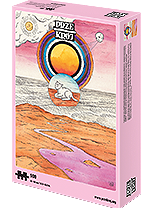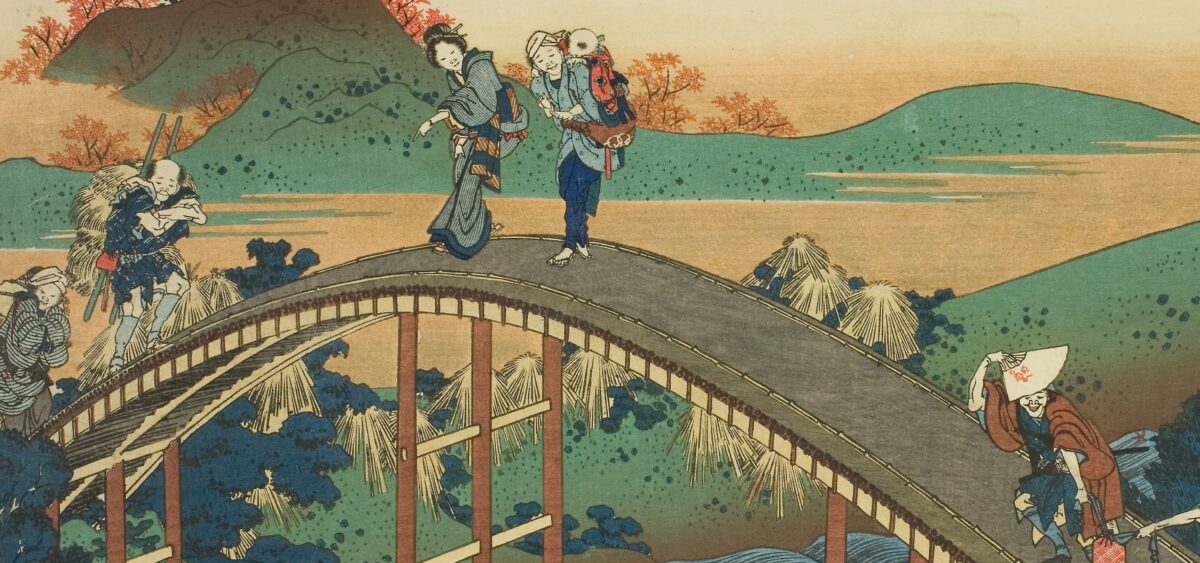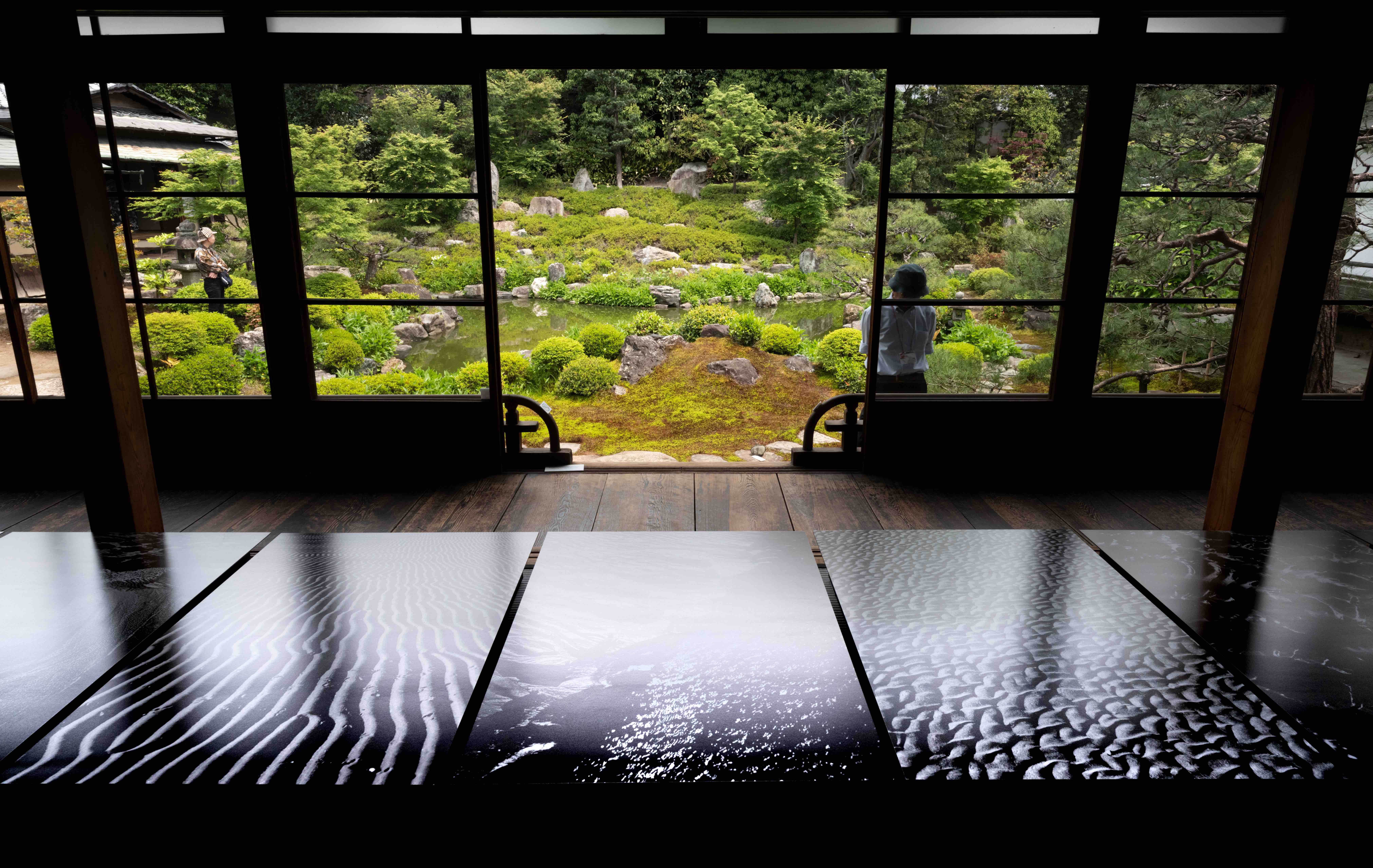
It doesn’t matter how long you live, but whether you live well, say the Japanese centenarians who have found the recipe for eternal happiness: find your goal and stick to it. Eat well, meditate and love – especially your neighbours.
It was a warm September afternoon. The sun was still quite strong, but the brown, low houses effectively suppressed the harsh light. We were in the Higashiyama District, the oldest part of Kyoto, whose winding, cobbled streets lead to the traditional 17th-century tearooms. The tea ceremony, known in Japan as chadō or sadō, was about to begin. Together with five other guests – tourists from Germany, China and Korea – we were invited first for a short walk around the Zen garden surrounding the building, and then to the tea pavilion. “Welcome to the tea road,” Akiko – the master of ceremony, dressed in a beautiful pastel kimono – greeted us. Her chadō lasted for over an hour and was a sequence of carefully studied elements: first the presentation of utensils and ceramics located in the pavilion, their brief contemplation, preparation of tea, consumption of the drink and traditional sweets specially selected for the occasion, conversation about tea, and finally cleaning and farewell. “How long have you worked here?” a German tourist asked Akiko. With the help of the translator, she answered. At first, she bowed her head modestly, saying that on her tea journey she was like a new-born that knows very little. She was 55 years old.
Many years later, I saw a short video on the internet. Masaaki Hiroi, an 80-year-old Japanese man, sat in a tiny carpentry workshop covered in wood shavings, and talked about the love of his life: moving wooden toys. He has been making them since he was 15 years old. All these years – despite the changing technology – he has invariably used a manually-operated machine. Hiroi likes to carve wooden tops that resemble various comical figures – a fat man eating ramen or a woman powdering her nose. They are set in motion by pressing the top of the toy. In the video, the old craftsman emphasized that whenever he begins working on a new toy, he feels as if he were young again. “I would like to live to be two hundred years old. I still have so many ideas! Woodwork and coming up with new, comical toys fill all my time,” he said energetically.
Why do you get up every morning?
What links the master of the tea ceremony Akiko and the carpenter Hiroi? The fact that they’ve found the meaning of life. They know what it is that they love doing, so they repeat this activity every day, improving their skills and enjoying the process. This approach is called ikigai, meaning: “The reason you want to get out of bed in the morning.” Héctor García and Francesc Miralles, authors of the book Ikigai: The Japanese Secret to a Long and Happy Life, who spent many years living and working in Japan, one day became interested in Okinawa, an island in the south of the country and an oasis of longevity. They decided to check how it was possible that for every 100,000 inhabitants there are 24 centenarians there, which is far above any global averages. What is more, the people of Okinawa not only live much longer than the rest of the world, but also develop chronic diseases such as cancer and cardiological disorders far less often. The recipe for Japanese longevity contains many ingredients: it is a good diet, simple life in the fresh air, green tea, the subtropical climate and strong local ties. But as Miralles and García emphasize, the most important thing is to find passion and cultivate it for the rest of your life. “Everyone has their own ikigai. And unlike many other things, it doesn’t cost much money,” they write in their book. But how to find it?
The deepest level of existence
Old Japanese people from the island of Okinawa tell their grandchildren this parable. A woman fell into a coma, and her body and soul hung between heaven and earth. Finally, she entered heaven, where the spirits of her ancestors spoke to her.
“Who you are?” they asked.
“I am the wife of the mayor,” she replied.
“We didn’t ask whose wife you are but who you are.”
“I am the mother of four children.”
“We didn’t ask whose mother you are but who you are.”
“I’m a teacher”.
“We didn’t ask what is your occupation, but who you are.”
“I’m a Shintoist.”
“We didn’t ask what religion you profess, but who you are.”
And so on, endlessly. She heard the same question for each answer: “Who are you?” And finally she said: “I am a person who gets up every morning to take care of my family and the minds of my young pupils at school.”
This answer satisfied the ghosts. They sent the woman back to the land of living. From that moment on, she woke up every day knowing that she had something to get up for. She found her own ikigai.
The concept of ikigai lies at the intersection of four categories that govern our lives: profession, passion, mission and vocation. In other words, it’s what you love to do and what you’re good at, but also what others can pay you for and what the world needs. Ikigai is the deepest level of our existence. Because, as the Japanese emphasize, it doesn’t matter how long you live, but whether you live a good life.
Brain for stimulation
Can work be our ikigai? The Japanese will probably politely nod in agreement. If this is the case, not only do we not feel how many hours a day – eight, twelve or four – we spend working, but we also do not even dream about something like retirement. Hokusai, a 19th-century Japanese woodcut artist, worked until he was 88. “Anything I did before seventy does not deserve to be mentioned,” he would say. Animated film director Hayao Miyazaki announced his retirement at the age of 72. But the next morning, his colleagues found him drawing diligently at his desk. He officially retired from retirement three years later, when he started working on another feature film. He plans to finish it for the 2020 Olympic Games in Tokyo. He will be 80 years old. Jiro Ono, a well-known sushi master, owner of a Tokyo restaurant awarded with three Michelin stars and the hero of the 2012 movie Jiro Dreams of Sushi, also believes in working until the end of one’s life. When giving an interview in 2015, he was 88 years old. Nonetheless, he not only did not intend to pass the restaurant chef’s baton to his very mature sons, but also loudly planned the menu for the next few years. Of course, not only the Japanese can turn a profession into ikigai. Work enthusiasts live all over the world. Among them are, for example, the 88-year-old architect Frank Gehry or 90-year-old naturalist and TV presenter David Attenborough.
Why does prolonged activity do people well? It is the mind that decides how quickly we age. Research at Yeshiva University in New York shows that long-lived people share a positive approach to life, focusing on small, everyday pleasures, as well as sufficient emotional expression. Interestingly, despite the fact that stress in high doses is the enemy of longevity, its constant, moderate level turns out to be beneficial for people because it provides continuous exercise for the mind and slows down the breakdown of neuronal connections. Neurobiologist and psychologist Shlomo Breznitz maintains that the brain needs a lot of stimulation to stay fit. Routine, although it saves a lot of stress and makes life easier, can be lazy for nerve cells in the long run. “People, and especially the elderly, like to do everything as they have always done. When the brain creates strong habits, it no longer needs the thinking process, and this degrades it,” explains the scientist. So, once in a while we should confront it with new circumstances and new challenges, preferably ones whose completion lies within our limits. “Or a little further than we think these limits might be,” adds Breznitz.
Become water
Imagine you are a hobby gardener. Every morning you get up an hour earlier than other family members just to run from the terrace into the garden and check on your plants. In the spring, you sow vegetables, in the summer you harvest them, and in the autumn you clean and fertilize the soil. In the evening, you often fall asleep to the view of new species of flowers that have just begun to bloom. When a tree gets sick, you search for medicine for hours.
When you work in your garden, you stop controlling the passage of time – you simply are and enjoy what you are doing. “You become water,” as Bruce Lee would say. The boundaries of your ego dissolve, and you enter a state that psychologists call flow. The well-known American psychologist of Hungarian origin, Mihály Csikszentmihályi, claims that flow is the easiest way to happiness. Why is that? “The best moments in our lives happen when we sink into something so deeply that nothing else matters. It’s an experience of pleasure, creativity and fulfilment,” he explains. His research shows that artists, athletes, scientists working on important discoveries, chess players, surgeons performing surgery and chefs all fall into the same euphoric state of flow. From a neurobiological point of view, concentrating on an absorbing activity diminishes the activity of the prefrontal cortex, which is responsible for important cognitive functions: working memory, planning actions or assessing their consequences. In other words, during flow, the operational part of our brain slows down, and we lose the ability to properly estimate the passage of time. “And that’s good, because in this way we can truly delve into here and now,” explains science writer Steven Kotler.
“Why does life seem so frustrating? Not because of the proximity of death or pain, anxiety or hunger, but because of constant movement, noise and crazy attempts to break away from experiencing one’s self, from being present in the present. To understand music, you must listen to it. But as long as you are thinking: ‘I am listening to music now’, you are not listening to it at all. In a material sense, there is nothing, there never was and will never be anything other than the present,” wrote the British philosopher and Buddhist Alan Watts in The Wisdom of Insecurity.
Reading the words of the Japanese elderly, which Héctor García and Francesc Miralles gathered in their book, one can conclude that each of them spent most of their lives in the regenerating state of flow.
Resistant despite scratches
A popular Japanese proverb is Nanakorobi yaoki, meaning: “If you fall seven times, get up eight times.” Ikigai is associated with mental resilience. And this, in turn, is possible thanks to firmly sticking to the chosen life path, not relegating to hedonism and temptations (especially pleasures that promise quick gratification: stimulants, overeating or toxic emotions), as well as a stoic attitude. The ability to remain calm in the face of difficulties has a positive effect on prolonging youth, because it reduces the level of anxiety and stress and introduces balance to our behaviour – emphasize the authors of Ikigai.
To learn how to control negative emotions, it is worth practicing meditation and calm consent to the present. Even those Japanese who did not graduate and do not know the teachings of Eastern philosophy implement these principles. Every day they try to heroically accept what fate and nature have given them. Hundreds or thousands of destroyed towns and villages are rebuilt in Japan after each earthquake and tsunami. The Japanese believe that it is worth gluing each broken dish back together many times, and that the glued places do not need to be masked, because they testify to the beauty of the experience; both the good and the bad. It is interesting to look at Japanese ceramics – bowls with irregular shapes and visible scratches – or Japanese gardens that look as if they were formed by nature itself, not by the human hand. “The world is not perfect, so why should our creations be?” Japanese craftsmen seem to be asking. This approach is called wabi-sabi, or seeing beauty in the ephemeral and imperfect nature of everything that surrounds us. This is one of the key principles of living in the spirit of ikigai.
The ikigai philosophy is not as exotic a psychological concept as it may seem. Its Western counterpart is logotherapy, a school of psychotherapy created by the Austrian psychiatrist Viktor Frankl. His method, called the Third Viennese School, focused on letting the suffering person find their sense in life by learning and accepting themselves and the world in which they operate. How did Frankl help patients who came to him with neurosis, depression and anxiety? First, he asked them: “Why don’t you commit suicide?” Thanks to this question, they realized not only what they were living for, but also what was the true meaning of their existence. And, as Frankl used to say, quoting his favourite philosopher Friedrich Nietzsche: “He who has a why to live for can bear with almost any how.”
Do you want to know how to find your ikigai? During his lectures, Buddhist Alan Watts offered the students the following exercise. He asked them to imagine that they had enough money to meet all their material and immaterial needs. “So if money ceases to be a problem, listen to yourself and think: who am I and what is most important to me? Where do I want to go and what to do?” If you can answer this question, you probably just discovered your ikigai. So live at least hundred years – cheers to that!









